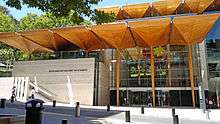Richard Francis-Jones
Richard Francis-Jones (born 1960, Hertfordshire, England) is an Australian architect. He is the design director of the Australian architecture practice Francis-Jones Morehen Thorp (FJMT) and is a Visiting Professor at the University of New South Wales. He is a Fellow of the Australian Institute of Architects and an honorary fellow of the American Institute of Architects.[1]
Education
Francis-Jones graduated from the University of Sydney with a Bachelor of Science (Architecture) in 1981 and a Bachelor of Architecture with First Class Honours and the University Medal in 1985. He attended Columbia University on an ITT Fellowship, where he studied under Kenneth Frampton, completing a Master of Science in Architecture and Building Design in 1987. He subsequently taught at Columbia University as an Adjunct Associate Professor of Architecture. In 2004 he was appointed as a Visiting Professor at the University of New South Wales.[2]
Practice
Following his studies at Columbia University, Francis-Jones practised at firms in New York, Los Angeles and Paris before returning to Sydney in 1989 where he joined FJMT’s predecessor, MGT Sydney. He became a director of the firm in 1996 and was a founding partner of Francis-Jones Morehen Thorp in 2003.
FJMT has a reputation as an ideas-driven practice "with an agenda for strong public engagement and masterful resolution of tectonics"[3] and the firm’s work demonstrates "an extraordinary ability to uncover the real and often contradictory issues and potentials of a project by a very careful analysis of purpose and place".[4]
Most of the firm’s major commissions have been won by competition and Francis-Jones is supportive of the power of the architectural competition to produce good architecture and create new opportunities for practices: "the more public the competition… the greater the contribution to the wider culture of architecture."[3]
Francis-Jones’ approach is a response to the transition from industrial to digital economies and investigations utilising emerging sciences and technologies are evident. Yet, Francis-Jones considers, the potential of this knowledge to address society’s challenges and give architects new scope for imagination is limited by the tendency for architecture to be reduced to fetishised object for consumption.[5] "An authentic contemporary architecture should not only attempt to somehow begin to reconcile humanity’s place in the world but also be directed towards rejuvenating, repoliticising our desiccated public realm. We should pursue an architecture appropriate to citizens rather than consumers."[6]
Francis-Jones was the creative director of the Australian Institute of Architects’ 2008 National Conference, Critical Visions: Form Representation and the Culture of Globalisation, and is an editor of Skyplane and Content: a journal of architecture. Francis-Jones was President of the RAIA (NSW Chapter) from 2001–2002 and was a member of the NSW Architects Registration Board from 2001-2004.
Notable projects
- The Red Centre, University of New South Wales[7]
- The John Niland Scientia, University of New South Wales[8]
- Sydney Harbour Moving Image Centre, Circular Quay (unbuilt)
- Sydney Mint redevelopment[9]
- Max Webber Library, Blacktown[10]
- Owen G Glenn Building, University of Auckland[11]
- Sydney Law School, University of Sydney
- Surry Hills Library & Community Centre[12]
- Bayside Police Station, Sandringham
- Darling Quarter, Sydney[13]
- Auckland Art Gallery Toi o Tamaki[14]
- Mark Wainwright Analytical Centre (MWAC), UNSW[15]
- St. Barnabas, Broadway
- Charles Perkins Centre, University of Sydney
- Liberty Place, Sydney
- Bankstown Library and Knowledge Centre
- The Concourse, Chatswood
-

Max Webber Library, Blacktown
-

Surry Hills Library
-

Auckland Art Gallery redevelopment
Awards
- Australia Award for Urban Design 2012, PIA
- City of Sydney Lord Mayor’s Prize 2013, AIA (NSW)
- Greenway Award for Conservation 2005, AIA
- International Award 2012, RIBA
- International Public Library of the Year 2014, Danish Agency for Culture
- John Verge Award for Interior Architecture 2010, 2015 AIA (NSW)
- Jorn Utzon Award for International Architecture 2012, AIA
- Lachlan Macquarie Award for Heritage 2005, AIA
- Lloyd Rees Award for Excellence in Civic Design 2000, 2013, AIA (NSW)
- Milo Dunphy Award for Sustainable Architecture 2010, 2013, AIA (NSW)
- National Architecture Award for Public Architecture 2010, AIA
- National Architecture Award for Sustainable Architecture 2010, AIA
- NZ Architecture Medal 2012, NZIA
- Sir Arthur G Stephenson Award for Best Commercial Architecture 2013, AIA (NSW)
- Sir John Sulman Award for Outstanding Public Architecture
- Sir Zelman Cowen Award 2000, AIA
- WAF Office Category Winner 2011, 2014
- World Building of the Year Award 2013, WAF
References
- ↑ http://www.aia.org/practicing/awards/2012/honorary-fellows/index.htm "2012 Honorary FAIA Announcement"
- ↑ , Richard Francis-Jones curriculum vitae
- 1 2 Watson, F. & Hook, M. (March–April 2010). "Francis-Jones Morehen Thorp (fjmt)". John Wiley & Sons. Architecture Media. 80 (2): 118–125. doi:10.1002/ad.1055.
- ↑ Heneghan, T. (May–June 2006). "Max Webber Library". Architecture Australia. Architecture Media. 95 (3): 86–95. Retrieved 2010-12-01.
- ↑ Jackson, Davina (2005). "Francis-Jones Morehen Thorp, Sydney". 10 x 10_2: 10 Critics 100 Architects. Phaidon Press. pp. 120–123. ISBN 978-0-7148-3922-6.
- ↑ Francis-Jones, Richard (2000). "The (im)possibility of slowness: a note on globalisation, ideology and speed in contemporary architecture". 10 x 10: 10 Critics 100 Architects. Phaidon Press Limited. pp. 433–434. ISBN 978-0-7148-3922-6.
- ↑ Red Centre, University of New South Wales
- ↑ John Niland Scientia, University of New South Wales
- ↑ Architecture Australia: The Mint, Jan/Feb 2005
- ↑ Max Webber Library
- ↑ Owen G Glenn Building Business School, University of Auckland
- ↑ Surry Hills Library & Community Centre
- ↑ Darling Quarter, Sydney
- ↑ Architecture Now: "Auckland Art Gallery Toi o Tamaki"
- ↑ UNSW Faculty of Science#Mark Wainwright Analytical Centre
External links
- FJMT website
- Richard Francis-Jones essays and bibliography
- Critical Visions - AIA National Conference 2008
- FJMT Australian Institute of Architects awards